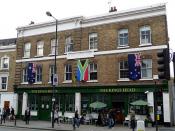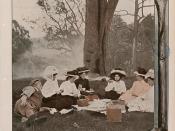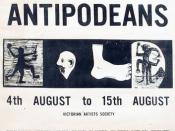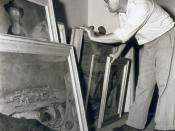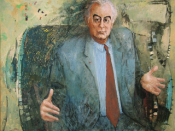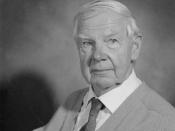The growing uncertainty within the art world, with a difference in conservative ideals and a growing indulgence in abstract art led a group of artists to counter the promotion of abstract art over figurative work. The collection of artist made the Antipodean Group, the main focus was dissolving the promotion of abstract art, and its members.
During the time of the Antipodean Group Australia was in a time of renewed prosperity, as well as materialism and mechanism. There was a surge in the televisions purchased and people began to adopt the rockÃÂnÃÂroll attitude, with a growing rebellious youth being established within society. There was also a period of mass immigration after the war bringing economic prosperity. The United States was also becoming a major influence on the Australian lifestyle with consumer products and recognisable icons being imported. This prosperity was contrasted to the state of the indigenous people of Australia, Antipodean Group felt that this was not documented in abstract painting.
Prior to the formation of the Antipodean Group in 1959, there was the rise of abstraction within Australian Art. Although temporarily masked behind the Social Realist era abstraction had continued from the late 30s and 40s given a second wave of artists within the 1950s. The motivation and inspiration however remained the same, as artists were captivated by many of the styles and techniques being used in Europe at the time.
An example of the abstraction is Roy de Maistre, famous for employing the disciplines of music and colour and combining both on one scale. This left for works full of explosive colours and explored a visual scale rather than a musical one. The works were abstract in its purest form such an example is Arrested phrase from Haydn Trio in orange-red minor. The music spectrum seen didnÃÂt form an emotional response and were perceived by the Antipodeans as ÃÂbland and pretentiousÃÂ, and the subject matter did little to involve the viewer. The Antipodeans didnÃÂt appreciate the lack of understanding to the surroundings and people. Where de Maistre was fantasised with colour and music the Antipodeans saw more potential on people as the subject matter.
Another significant artist was Frank Hinder, who was part of the second wave of abstraction. Hinder became was interested in the development and illusion of movement and how it can be displayed, following the ideas of the Italian Futurists. Again Hinder was influenced by European ideas; such can be seen in Subway Escalator, on the right. Brief figures are seen however are distorted, fragmented and blurred in what becomes a haze to the viewers eye. The world has been clearly changed into geometric shapes and then clustered together, similar to the Cubists. This is another reason the Antipodeans were against abstraction. At the time art from Australia could easily have been mistaken for something produced in Europe.
As such many of these artists fuelled the Antipodean Group into seeking a new modern way of painting. The group believed that the abstraction painting would scar the Australian Art scene. This then led them to publish a manifesto stating how Australian Art must be contained, and not use international ideas this meant observing their environment. Abstract art was viewed as, ÃÂnot an art sufficient for our time ... not an art for living menÃÂ. The manifest was considered by local artists as a statement that illustrated a conservative view, and tried to isolate Australian Art from the international scene. This is true in a sense that many of the artists that were part of the group went through a highly conservative education as such the manifesto can be viewed as bold reaction against the ideals and untraditional styles being adopted. However the manifesto can also be viewed as statement to try and separate the Australia from the international art world to establish its own identity and the Antipodeans themselves believed it was conservative to paint abstract. This idea of establishing an identity for Australian Art was very prominent in the Post-Colonial era and the entering into Modernism.
The main artists involved in the group were John Brack, Charles Blackman, Arthur and David Boyd, John Perceval, Clifton Pugh, Robert Dickerson and the art historian Bernard Smith. Robert Dickerson was one of the main contributors to the group. His works explored the relationships with humans and existence DickersonÃÂs The Tired Man is a prime example, It shows the human relationships within a modern world, however does not endorse a realistic style contrary to the belief that with the exclusion of abstraction painting becomes a highly traditional process. The viewer is left wondering about the figure, and speculates on the identity and state of the man. The landscape is seen a vast and uninhabited. The painting is bears resemblance too many of DickersonÃÂs other works which detail isolation.
Another example is The Bank Clerk. The figure seems alone in a harsh backdrop that dwarfs the character while he remains focused on the viewer with large innocent eyes dealing with the burden of modern life. As such DickersonÃÂs work represents the perception of the Australian environment, especially the city, and its effects on modern life. These were some of the commonly held ideals of the Antipodeans. Also the imagery is highly orientated around the figure to express direct emotions. The works have a clear focus and meaning which is communed to the viewer, perceived by the Antipodeans as a more effective means than abstraction.
Another example of the Antipode ideology can be seen in the work of Arthur Boyd and Russell Drysdale. Both Boyd and Drysdale made use of the narrative history of the country combine it with other legends and myths. The most prominent of these were a set of studies into Aboriginal people. Boyd was shocked after seeing the standard of living conditions the people were living in. His works often depicted dream-like imagery, and Boyd viewed the gap between cultures, the works tackled issues such as racism, acceptance, rejection, love and pain. These wide and universal ideas mirror that of the Angry Penguins.
DrysdaleÃÂs works painted a bleak outline of the Australian environment Again the use of figure is used as an emotional response to the hardship of the aboriginal people, expressing mood and attitudes. He also documented the isolation in the rural communities such as in Man feeding his dogs. The work, which can be seen on the right, is marked with desperation, with thin figures that give a withering sense of the whole landscape. The images depicted were bleak, real, representations of the environment and were confronting to the viewer.
The works featured show a number of contrasts in the abstract and the antipodean era. The Antipodean Group countered the growing abstraction in Australian Art through figurative works that communed to the viewer, often with very powerful messages on universal themes. It is this separation and re-positioning of the focus of Australian art that help move away from the dependence on international ideas.
Bibliography: In Our Own Image The Story of Australian Art, 1788-1989; WILLIAMS, DONALD. Offered by Lamdha Books.
Art of Australia,Wikipedia, Online Resource, Found at http://en.wikipedia.org/wiki/Art_of_Australia
